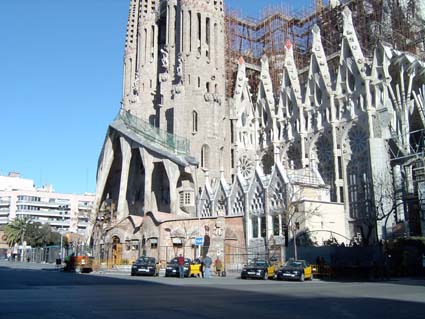Contents
Basic information
Location: Sardenya street corner of Mallorca street into the Sagrada Família enclosure – Barcelona Map
Qualification: xx (2 on 5)
Present condition: Good, instead of the building was destroyed in 1936 and again in 1939, during the civil war. The reconstruction was made with some changes in the building characteristics. Nevertheless the external aspect respects its original design.
How to go to: Buses: 19, 33, 34, 43, 44, 50, 51, B20, B24, N1, N7
Metro: L2, L5 (Sagrada Família)
Visits: Into the Sagrada Família enclosure.
Available guides: In the shop of the temple, and other “souvenirs” shops around it, it is possible to buy a small guide “The Parish school of the Sagrada Família” at the price of 3 €. Also other bibliographic material is available.
Timings, prices and other information can vary, please verify it previously.
Handicapped accessibility: Building with only a ground floor, with entry at the street level.
History
The construction of this school is connected with the need to assure the education of the workers children of the Sagrada Família. Between the objectives of the “Congregation sing of Sant Josep” (builders of the temple) the infancy and youth education was essential. The person entrusted by the Congregation to carry out this objective was the Father Gil Parés i Vilasau (1880-1936) that entrusted to Gaudí a simple but efficient project of school and at the lowest possible price.
Gaudí prepared a project in the year 1908 following the instructions of the Father Gil. Just as him it had been asked, Gaudí did an extremely simple, but at the same time genial approach. The budget was of 9000 Pesetas of that epoch (54 €).
The material predicted was Catalonian brick for the walls, without no covering and in the interior two walls to separate the three classrooms and three metallic pillars to support a double T beam to support the roof of conoidal structure.
The construction:
In the year 1909 and while in the church of the Sagrada Família the façade of the Nativity went growing, the work of these schools was carried out, inside the same precinct of the temple, both not exactly in the same place of the present building.
This year the tragic revolutionary events known as “The Tragic week”, does not affected to the works of the Sagrada Família temple neither to the school.
The works were finished in autumn of 1909 and quickly the classes were initiated.
Educative System
The Father Gil Parés i Vilasau was a religious people quite advanced for the standards of that time. Very quick after his ordering, he was named priest of the Sagrada Família by the Cardinal Casañas and he remained in this charge for more of thirty years.
As the educator of this school, he adopted very quickly the methods of the active education developed by Maria Montessori. For him, the education had to be so instructive and practical as possible. Also he liked to give the teachings out of the classes, outdoors, because this permitted to the children to be more in contact with the nature.
The quality of this teaching had been recognized for educators as Artur Martorell who admired very much the work of Father Gil Parés.
Some writing testimonies remain on these opinions as the long article that “Ilustración Catalana” (Catalonian Illustration) dedicated him in the year 1914.
Gaudí interpreted perfectly this message of efficient simplicity transmitted to him by Father Gil.
Destruction and Reconstruction
The building had being utilized for the same initial function until the year 1936.
July twenty, once the military coup d’etat defeated in Barcelona, the revolutionary groups burned and destroyed the school. The fire affected the beams of wood supporting the roof that sank down. The furniture and in general the content of the school were destroyed.
The students consequently remained without school, what did that the CENU (Committee for the New Unified School) entrusted to the architect Francesc de Paula Quintana the reconstruction of the building.
The project of this architect fortunately recognized the value of the work of Gaudí and intended to maintain its character and characteristics, with the exception of some elements that were considered then as improvements of the original project as a consequence of the new technologies.
The majority of the original elements of the building disappeared, but the work was basically respectful with the initial project of Gaudí. The modifications were carried out basically in the interior with the addition of a false cork ceiling as insulating element, the plastered of the walls and double windows.
The classes could be restarted during the spring of 1937, but unfortunately without their founder and soul, the Father Gil Parés that, as so many other religious, was died during the revolutionary facts produced in the initial days of the civil war (1936-1939).
New Destruction
Again the month of January of 1939 a new fire that was not as destructive as the first one, affected this time the pedagogical material, books, etc. that were burned by the simple reason that it were writing in Catalonian.
The classes could be restarted in the spring, every trace of the country tongue – the Catalan – having been totally eradicated, in the beginning of one of the longer periods of pursuit of our culture.
Transfer and Restoration
In the meantime, the works of the temple of the Sagrada Família went advancing to the point that the existence of the school was an important obstacle to make difficult and even impeding the construction.
The “Institut Gaudí de la construcció” (Building Gaudí Institute), proposed the construction of a replica in its lands in Badalona (a town close to Barcelona). This permitted a deep investigation on the original project of Gaudí, with the result of new know-how on the employed techniques by Gaudí. These techniques were applied in the transfer and reconstruction of the building in a new location far away of the works of the temple, touching now to Sardenya street Sardinia, but always inside the same precinct.
The present time:
From ends of the 80s, the schools are no longer utilized for educational purposes. Now the building lodges the educational area of the Museum of the Sagrada Família and various models used in the construction of the temple.
Description
The provisional School of the Sagrada Família is a small building of only a ground floor built almost totally with Catalonian brick of 29x14x4cm.
The base is of masonry and the floor has a stone base, to assure the protection against the humidity.
The doors and the tipper windows were of wood.
The toilets situated to both sides of the building, had a direct exit to the playground.
The dimensions are 24 m. long, 12 m wide and 6 m height.
The roof, also of three layers of Catalonian brick, has conical vaults of extreme rigidity, that are supported by the walls and a laminated steel central beam of 220 mm.
This roof is itself one of the most characteristic elements.
The interior had three classrooms with a total capacity of 150 students.
Photo Gallery
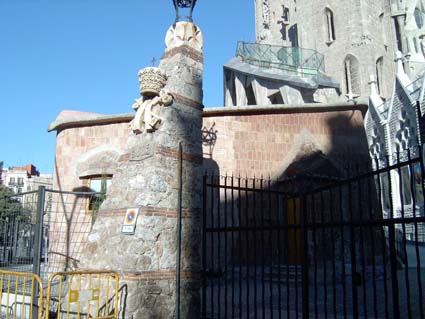
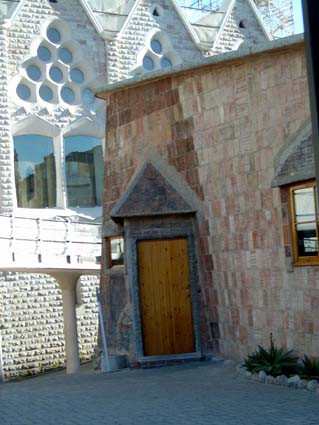
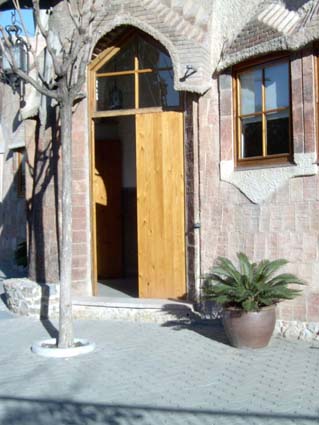
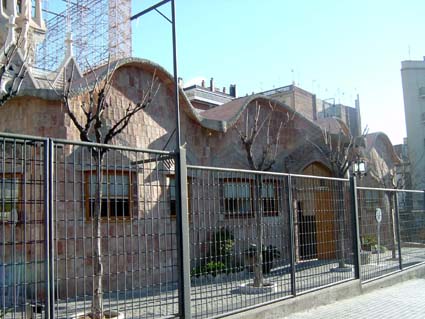
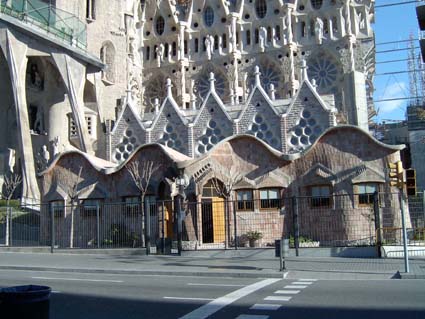
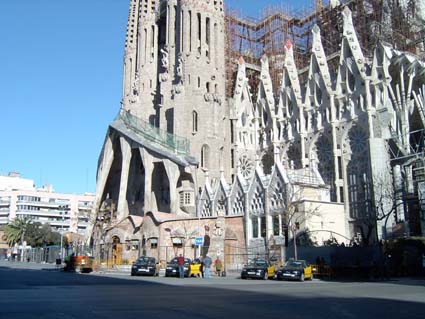
Specific Bibliography on the Sagrada Família Schools
|
|||
| Title | Author | Published by | Year |
| El gran Gaudí | Bassegoda Nonell, Joan | Ausa | 1989 |
| Antoni Gaudí: l’home i l’obra | Bergós, Joan | Ariel | 1954 |
| The Parish school of the Sagrada Família | Bonet i Armengol, Jordi | Editorial Escudo de Oro | 2002 |
| Temple de la Sagrada Família | Bonet i Armengol, Jordi | Editorial Escudo de Oro | 1997 |
| Gaudí | Le Corbusier / Gomis-Prats | Editorial Polígrafa | 1967 |
| Gaudí: su vida, su teoría, su obra | Martinell, Cèsar | Col·legi d’Arquitectes de Catalunya i Balears | 1967 |
Other Works of Gaudí
In Barcelona: Bellesguard | Eduard Calvet House | Batlló House | Vicens House | Santa Teresa School | Sagrada Família Schools | La Pedrera | Güell Pavilions | Güell PalacePark Güell | Sagrada Família | Miralles Property Fence
In La Pobla de Lillet: Catllaràs Villa | Artigas Gardens
In Mataró: Workers Cooperative building (attributed)
In Montserrat: Monumental Rosary path (1st mystery of Glory)
In Santa Coloma de Cervelló: Colònia Güell Crypt
In Garraf (Sitges): Garraf Cellars
Out of Catalonia: Botines House (León) | El Capricho (Comillas) | Episcopal Palace (Astorga)

